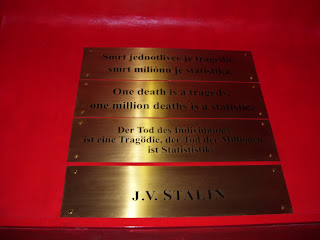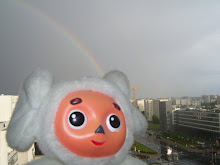Cities like London, Paris and Rome are often cited as the most beautiful cities in Europe (or in their own minds: the world.) Prague is able to elevate itself above these by still retaining its mystique. It has modern amenities, swarms of youths, and an influx of attention, but this old imperial capital still calls back to history with its architecture.

The Old Town Square from the Prague Astronomical Clock.

The Opera House where Mozart's Don Giovanni was first performed.

The Powder Tower at night with a full moon.
One thing was a mind-boggling amount of tour groups. Tours from France, Russia, Germany, and England. Tour guides strode about hold aloft various objects like umbrellas, rods with colorful balls or small figurines perched on top.
There is tons of history in Prague, from the Thirty Years War (and before) to Franz Kafka (a house where he lived is there on the Old Town Square. There's a delightful little restaurant underneath it called U Minuty, which I guess is also the name of the house itself.) There's also much more, but I'm just giving you an idea.

Prague from the Astronomical Clock.
The day I arrived, New Years Eve, was a very sunny day. It was perfect for discovering a new city. The day I left was an extended day, and I was frantically trying to escape the city.
The Charles Bridge (Karluv Most) is a central sight in the city. It serves as the main pedestrian link between the two halves of Prague. It's adorned by many fantastic statues and has plenty of entertainment, from street musicians to caricature artists. Most disappear at night, but that didn't stop some American neo-bohemian to sit below the bridge tower, strumming a six-string and repeating the end of Pink Floyd's "Wish You Were Here" over and over. "How I wish… How I wish you were here…" Artisans and hawkers also line the sides of the bridge.
The National Museum is a grand sight. It stands, imposingly, over Wenceslas Square. It's interior is rich and majestic. The entrance hall feels more like a theater than a museum (they actually have classical music concerts in it sometimes.) As for the actual museum collection, don't bother. It's rather dry and boring. Go visit some other natural history museums for their exhibits; visit this one for the structure itself.

Wenceslas Square from the New Yorker store, looking up at the National Museum.
Prague is also home to an exciting-looking sex toy museum as well as a pretty decent torture device museum. (As I say: The torture device of today is the sex toy of tomorrow.) I say "exciting-looking" because I've never actually been in it, but the entrance was pretty interesting. The torture museum, near the Charles Bridge, was pretty interesting and pretty extensive.
One museum, which is a must, is the Museum of Communism. It's above a big McDonald's, and it mixes humor and history. Much of the exhibits are tongue-in- cheek, but that doesn't mean the museum doesn't mean business: it does. I wish I could actually compare it to the Museum of Communism in Warsaw (in the Palac Kultury i Nauki), but I haven't actually been to that one yet. When I have, I'll certainly tell all.
The Museum of Communism deals mostly with communism in Czechoslovakia (primarily the Prague Spring), with a little bit about it's Eastern Bloc neighbors. It's pretty damning of communism in general by making points to show how oppressive the regime was as a satellite state.


And some people still believe in Communism.
Cafe Ebel, which has several locations throughout Prague, is a terrific coffee spot. The 'Jumbo Lattes' are just that: enough coffee to bathe a small elephant. (Seriously, they're fucking huge.) Breakfast there was good, cheap, and fast.
Restaurace Achát was pretty good with a pleasant atmosphere and the expected traditional Czech dishes.
The Prague Castle, which is apparently the largest ancient castle in the world, is, as all castles should be, magnificent. It sits atop a hill, and overlooks all of the Old City in Prague. From the Charles Bridge, one runs into St. Nicholas Church (be careful, there's another St. Nicholas in Prague in the Old Town Square, but I believe it's a Hussite church.) Inside, it's as you would expect: beautiful. There is, however, much to explore. Not just within the castle and the St. Vitius Cathedral, which has a very rewarding view from it's spire, but also further back where not many tourists go.

The Monument in front of St. Nicholas.



Different views of the Prague Castle.
The Stahov Monastery is pretty nice. I didn't notice tons of tourists walking about, so I don't think it's a main attraction of Prague. The Loreta and Loretanske Namesti, are both worthy places and not too far from the Prague Castle. The Loretta is a must-see. It holds a wonderful treasury (I don't think pictures were allowed to be taken) and a nice cloister-esque courtyard. I visited it when it was rather drizzly and dreary, but they seemed to be devoid of most tourists.
The Old Town Square in Prague is pretty much what you would think it is, central to the whole city. There's a gigantic statue to Jan Huss, and for the time I was there, a large Christmas Market (Weihnachtmarkt in German.) They sell all sorts of crafts and food (winter food: candied nuts, sausages, mulled wine.) In the summer, I'm sure it's full of restaurants' patios and such. Famous sites like the Astronomical Clock and Kafka's house are there.


St. Nicholas at night, with the Weihnachstmarkt.
I had read about the Vysehrad, which promised to be impressive. I walked along the river towards the south, running into several sights such as the modernistic "Fred and Ginger", the Prague National Theater, and the Emauzy Monastery. Emauzy actually is in a rather seedy neighborhood, quite to my surprise.

Fred and Ginger.

Emauzry.
My first attempt to visit the Vysehrad ended after I walked along the Vltava for a ways and decided to turn back. My second, and successful, visit occurred rather late at night while waiting for my bus.
I was supposed to leave on the fourth of January, at midnight. I packed up all my stuff; I checked out of the hostel and went to the seedy bus station. The bus was supposed to leave at midnight (how convenient is that?) But I waited and waited and waited some more. It never came! I asked another bus driver if I could get on her bus, but she said no and told me to wait for my own. Finally, I just gave up and went back to the hostel, where that old guy was still awake. The next evening, I did the same thing. I left my baggage at the hostel and went out into the city for one last time. I decided to actually walk all the way to Vysehrad.
The walk along the river was quite nice. It's true that it borders a busy road with cars ripping by, but during the sunset it can be quite peaceful (almost romantic—but by this time I was alone.) The setting sun shimmers off the Vltava, and it's winter (yet it was warm) so there aren't crowds of couples walking hand-in-hand.
I finally made it to Vysehrad. It's hard to miss, being a fortress on a hill, but it's not clearly marked out. The Prague Castle has signs everywhere pointing the way to it in both Czech and English, I can't remember a single one for the Vysehrad. It's a up a long flight of stairs, and one is immediately rewarded with a view over Prague.
It was quite dark, so my impression of Vysehrad is that it's mostly parks and ramparts. There were a scattering for people going about for evening strolls. At the center, there's the Church of St. Peter and St. Paul, which pretty much dominates over the whole thing. St. Peter and St. Paul has beautiful, colorful doorways with mosaics above them. They seem a little odd on a gothic church, but compliment it well. I spent a while wandering around on the ramparts. If I had, had more time (I had to take a bus later) and had gotten there in the daylight, I would probably have more to say.
I walked back to the center of the city and spent the rest of the time at one of the Cafe Ebels. This time, when I went to the bus station, I caught the bus for another long ride to Karlsruhe.









No comments:
Post a Comment